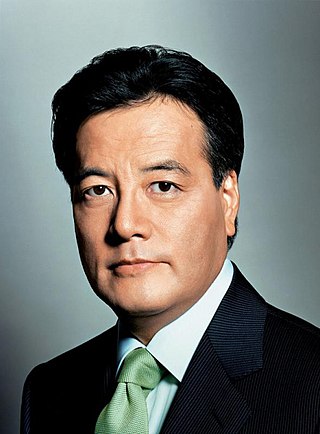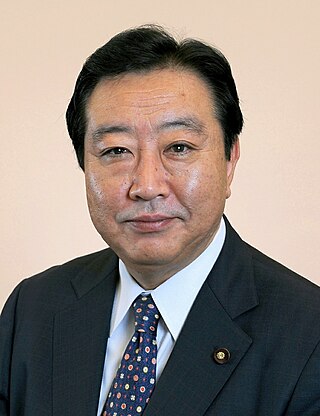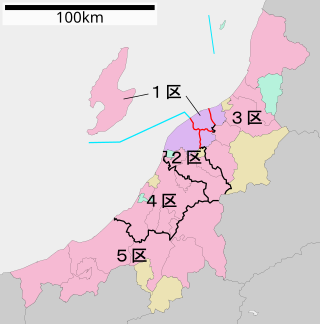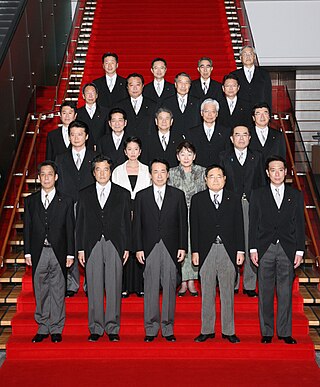
Politics of Japan are conducted in a framework of a dominant-party bicameral parliamentary constitutional monarchy, in which the Emperor is the head of state and the Prime Minister is the head of government and the head of the Cabinet, which directs the executive branch.

The Democratic Party of Japan was a centrist to centre-left liberal or social-liberal political party in Japan from 1998 to 2016.

Naoto Kan is a Japanese politician who served as Prime Minister of Japan and President of the Democratic Party of Japan (DPJ) from June 2010 to September 2011. Kan was the first Prime Minister since the resignation of Junichiro Koizumi in 2006 to serve for more than one year, with his predecessors Yukio Hatoyama, Tarō Asō, Yasuo Fukuda, and Shinzo Abe either resigning prematurely or losing an election. On 26 August 2011, Kan announced his resignation. Yoshihiko Noda was elected as his successor. On 1 August 2012, United Nations Secretary-General Ban Ki-moon announced Kan would be one of the members of the UN high-level panel on the post-2015 development agenda.

Ichirō Ozawa is a Japanese politician and has been a member of the House of Representatives since 1969, representing the Iwate 3rd district. He is often dubbed the "Shadow Shōgun" due to his back-room influence.

Katsuya Okada is a Japanese politician who was Deputy Prime Minister of Japan from January to December 2012. A member of the House of Representatives of Japan, he was the President of the Democratic Party, and previously of the Democratic Party of Japan. He also served as Secretary-General of the DPJ three times. During the DPJ's period in government he was Foreign Minister of Japan.

Hirohisa Fujii was a Japanese politician who was a member of the House of Councillors from 1977 to 1986, and of the House of Representatives from 1990 to 2012. He served two terms as Minister of Finance, and as Secretary General of the Liberal Party and the Democratic Party of Japan.

Seiji Maehara is a Japanese politician who is the founder and leader of the Association for Realizing Free Education and a member of the House of Representatives of Japan since 1993.

Yukio Hatoyama is a Japanese politician who served as Prime Minister of Japan and Leader of the Democratic Party of Japan from 2009 to 2010. He was the first Prime Minister from the modern Democratic Party of Japan. Hatoyama is currently the founder and leader of Kyowa Party, a minor political party established in 2020 after he announced his return to politics.

Kunio Hatoyama was a Japanese politician who served as Minister of Internal Affairs and Communications under Prime Ministers Shinzō Abe and Yasuo Fukuda until 12 June 2009.

House of Councillors elections were held in Japan on July 29, 2007. The date was originally to be July 22, but the ruling Liberal Democratic Party (LDP) decided in mid-June to extend the session of the House for a week to finish up legislative business; this step was criticised due to the short-term delay.

Yoshihiko Noda is a Japanese politician who served as Prime Minister of Japan and Leader of the Democratic Party of Japan from 2011 to 2012. He is a member of the Constitutional Democratic Party of Japan, and a member of the House of Representatives in the Diet. He was named to succeed Naoto Kan as a result of a runoff vote against Banri Kaieda in his party, and was formally appointed by the Emperor Akihito on 2 September 2011.

Yukio Edano is a Japanese politician who served as the leader of the Constitutional Democratic Party of Japan from its formation in 2017 until 2021. A member of the House of Representatives in the Diet since 1993, he served as Chief Cabinet Secretary and Minister of Economy, Trade and Industry in the Democratic Party of Japan (DPJ) government from 2010 to 2012.

General elections were held in Japan on August 30, 2009 to elect the 480 members of the House of Representatives. The opposition Democratic Party of Japan (DPJ) defeated the ruling coalition in a landslide, winning 221 of the 300 constituency seats and receiving 42.4% of the proportional block votes for another 87 seats, a total of 308 seats to only 119 for the LDP.

General elections were held in Japan on 16 December 2012. Voters gave the Liberal Democratic Party a landslide victory, ejecting the Democratic Party from power after three years. It was the fourth worst defeat suffered by a ruling party in Japanese history.

Tokyo 18th District is a constituency of the House of Representatives in the Diet of Japan. It is located in Western Tokyo and consists of the cities of Musashino, Koganei and Fuchū. Until 2002, it included Mitaka instead of Fuchū. As of 2016, 436,338 eligible voters were registered in the district.

House of Councillors elections were held in Japan on July 11, 2010. In the previous elections in 2007 the Liberal Democratic Party (LDP) had lost its majority to the Democratic Party (DPJ), which managed to gain the largest margin since its formation in 1996. The House of Councillors is elected by halves to six-year terms. The seats up for election in 2010 were last contested in the 2004 election.
Saga 1st district is a constituency of the House of Representatives in the Diet of Japan. It is located in Saga Prefecture and consists of Tosu, parts of Saga and Kanzaki as well as the Miyaki District. As of September 2012, 237,748 eligible voters were registered in the district.

House of Councillors elections were held in Japan on July 21, 2013 to elect the members of the upper house of the National Diet. In the previous elections in 2010, the Democratic Party of Japan (DPJ) remained the largest party, but the DPJ-led ruling coalition lost its majority. The House of Councillors is elected by halves to six year terms. In 2013, the class of Councillors elected in 2007 was up.

Niigata 5th district is a single-member electoral district for the House of Representatives, the lower house of the National Diet of Japan. It is located in the central, Chūetsu region of Niigata and covers parts of Nagaoka City, the cities of Ojiya, Uonuma, Minami-Uonuma as well as the former Minami-Uonuma County that, as of 2012, only has one remaining municipality: Yuzawa Town. As of September 2012, 282,904 voters were registered in Niigata 5th district, giving its voters above average vote weight.

The Kan Cabinet was the cabinet governing Japan from June 2010 to September 2011 under the leadership of Prime Minister Naoto Kan, who came into power after winning the DPJ leadership election in June 2010. The Kan Cabinet oversaw the response to the aftermath of the 2011 Tōhoku earthquake and tsunami and the scaling-down of Japan's nuclear energy dependence following the nuclear disaster at TEPCO's Fukushima Daiichi nuclear power plant.




















